Muhammad Atif Butt
GenColorBench: A Color Evaluation Benchmark for Text-to-Image Generation Models
Oct 23, 2025Abstract:Recent years have seen impressive advances in text-to-image generation, with image generative or unified models producing high-quality images from text. Yet these models still struggle with fine-grained color controllability, often failing to accurately match colors specified in text prompts. While existing benchmarks evaluate compositional reasoning and prompt adherence, none systematically assess color precision. Color is fundamental to human visual perception and communication, critical for applications from art to design workflows requiring brand consistency. However, current benchmarks either neglect color or rely on coarse assessments, missing key capabilities such as interpreting RGB values or aligning with human expectations. To this end, we propose GenColorBench, the first comprehensive benchmark for text-to-image color generation, grounded in color systems like ISCC-NBS and CSS3/X11, including numerical colors which are absent elsewhere. With 44K color-focused prompts covering 400+ colors, it reveals models' true capabilities via perceptual and automated assessments. Evaluations of popular text-to-image models using GenColorBench show performance variations, highlighting which color conventions models understand best and identifying failure modes. Our GenColorBench assessments will guide improvements in precise color generation. The benchmark will be made public upon acceptance.
Color Names in Vision-Language Models
Sep 26, 2025Abstract:Color serves as a fundamental dimension of human visual perception and a primary means of communicating about objects and scenes. As vision-language models (VLMs) become increasingly prevalent, understanding whether they name colors like humans is crucial for effective human-AI interaction. We present the first systematic evaluation of color naming capabilities across VLMs, replicating classic color naming methodologies using 957 color samples across five representative models. Our results show that while VLMs achieve high accuracy on prototypical colors from classical studies, performance drops significantly on expanded, non-prototypical color sets. We identify 21 common color terms that consistently emerge across all models, revealing two distinct approaches: constrained models using predominantly basic terms versus expansive models employing systematic lightness modifiers. Cross-linguistic analysis across nine languages demonstrates severe training imbalances favoring English and Chinese, with hue serving as the primary driver of color naming decisions. Finally, ablation studies reveal that language model architecture significantly influences color naming independent of visual processing capabilities.
An h-space Based Adversarial Attack for Protection Against Few-shot Personalization
Jul 23, 2025Abstract:The versatility of diffusion models in generating customized images from few samples raises significant privacy concerns, particularly regarding unauthorized modifications of private content. This concerning issue has renewed the efforts in developing protection mechanisms based on adversarial attacks, which generate effective perturbations to poison diffusion models. Our work is motivated by the observation that these models exhibit a high degree of abstraction within their semantic latent space (`h-space'), which encodes critical high-level features for generating coherent and meaningful content. In this paper, we propose a novel anti-customization approach, called HAAD (h-space based Adversarial Attack for Diffusion models), that leverages adversarial attacks to craft perturbations based on the h-space that can efficiently degrade the image generation process. Building upon HAAD, we further introduce a more efficient variant, HAAD-KV, that constructs perturbations solely based on the KV parameters of the h-space. This strategy offers a stronger protection, that is computationally less expensive. Despite their simplicity, our methods outperform state-of-the-art adversarial attacks, highlighting their effectiveness.
Leveraging Semantic Attribute Binding for Free-Lunch Color Control in Diffusion Models
Mar 12, 2025

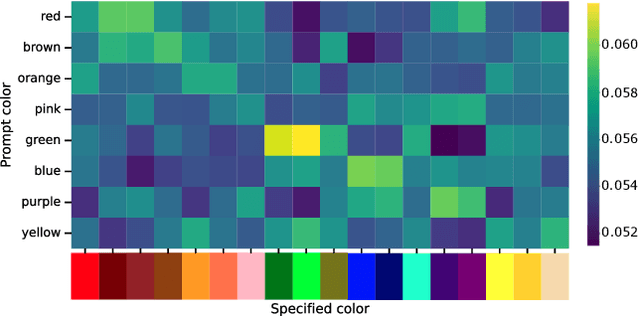

Abstract:Recent advances in text-to-image (T2I) diffusion models have enabled remarkable control over various attributes, yet precise color specification remains a fundamental challenge. Existing approaches, such as ColorPeel, rely on model personalization, requiring additional optimization and limiting flexibility in specifying arbitrary colors. In this work, we introduce ColorWave, a novel training-free approach that achieves exact RGB-level color control in diffusion models without fine-tuning. By systematically analyzing the cross-attention mechanisms within IP-Adapter, we uncover an implicit binding between textual color descriptors and reference image features. Leveraging this insight, our method rewires these bindings to enforce precise color attribution while preserving the generative capabilities of pretrained models. Our approach maintains generation quality and diversity, outperforming prior methods in accuracy and applicability across diverse object categories. Through extensive evaluations, we demonstrate that ColorWave establishes a new paradigm for structured, color-consistent diffusion-based image synthesis.
Privacy Protection in Personalized Diffusion Models via Targeted Cross-Attention Adversarial Attack
Nov 25, 2024



Abstract:The growing demand for customized visual content has led to the rise of personalized text-to-image (T2I) diffusion models. Despite their remarkable potential, they pose significant privacy risk when misused for malicious purposes. In this paper, we propose a novel and efficient adversarial attack method, Concept Protection by Selective Attention Manipulation (CoPSAM) which targets only the cross-attention layers of a T2I diffusion model. For this purpose, we carefully construct an imperceptible noise to be added to clean samples to get their adversarial counterparts. This is obtained during the fine-tuning process by maximizing the discrepancy between the corresponding cross-attention maps of the user-specific token and the class-specific token, respectively. Experimental validation on a subset of CelebA-HQ face images dataset demonstrates that our approach outperforms existing methods. Besides this, our method presents two important advantages derived from the qualitative evaluation: (i) we obtain better protection results for lower noise levels than our competitors; and (ii) we protect the content from unauthorized use thereby protecting the individual's identity from potential misuse.
ColorPeel: Color Prompt Learning with Diffusion Models via Color and Shape Disentanglement
Jul 09, 2024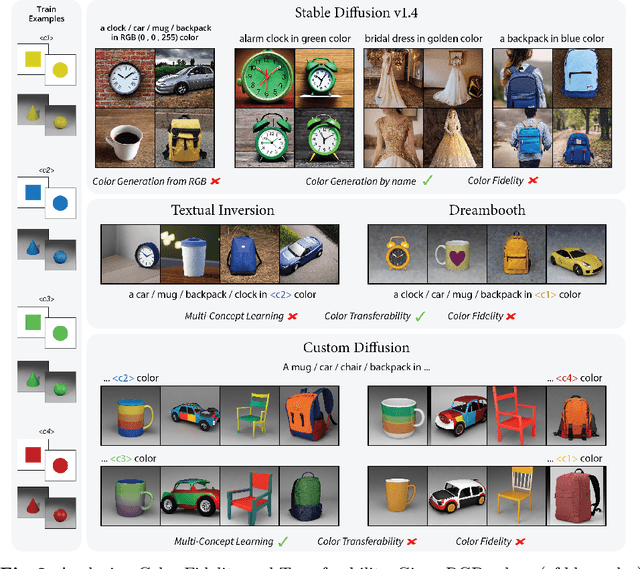

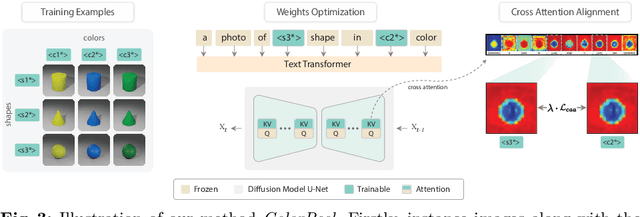
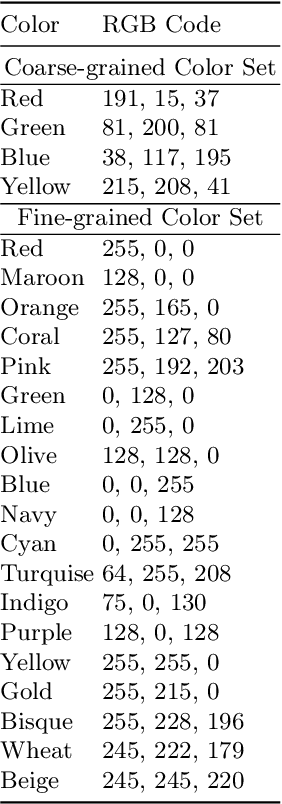
Abstract:Text-to-Image (T2I) generation has made significant advancements with the advent of diffusion models. These models exhibit remarkable abilities to produce images based on textual prompts. Current T2I models allow users to specify object colors using linguistic color names. However, these labels encompass broad color ranges, making it difficult to achieve precise color matching. To tackle this challenging task, named color prompt learning, we propose to learn specific color prompts tailored to user-selected colors. Existing T2I personalization methods tend to result in color-shape entanglement. To overcome this, we generate several basic geometric objects in the target color, allowing for color and shape disentanglement during the color prompt learning. Our method, denoted as ColorPeel, successfully assists the T2I models to peel off the novel color prompts from these colored shapes. In the experiments, we demonstrate the efficacy of ColorPeel in achieving precise color generation with T2I models. Furthermore, we generalize ColorPeel to effectively learn abstract attribute concepts, including textures, materials, etc. Our findings represent a significant step towards improving precision and versatility of T2I models, offering new opportunities for creative applications and design tasks. Our project is available at https://moatifbutt.github.io/colorpeel/.
Dynamic Prompt Learning: Addressing Cross-Attention Leakage for Text-Based Image Editing
Sep 27, 2023Abstract:Large-scale text-to-image generative models have been a ground-breaking development in generative AI, with diffusion models showing their astounding ability to synthesize convincing images following an input text prompt. The goal of image editing research is to give users control over the generated images by modifying the text prompt. Current image editing techniques are susceptible to unintended modifications of regions outside the targeted area, such as on the background or on distractor objects which have some semantic or visual relationship with the targeted object. According to our experimental findings, inaccurate cross-attention maps are at the root of this problem. Based on this observation, we propose Dynamic Prompt Learning (DPL) to force cross-attention maps to focus on correct noun words in the text prompt. By updating the dynamic tokens for nouns in the textual input with the proposed leakage repairment losses, we achieve fine-grained image editing over particular objects while preventing undesired changes to other image regions. Our method DPL, based on the publicly available Stable Diffusion, is extensively evaluated on a wide range of images, and consistently obtains superior results both quantitatively (CLIP score, Structure-Dist) and qualitatively (on user-evaluation). We show improved prompt editing results for Word-Swap, Prompt Refinement, and Attention Re-weighting, especially for complex multi-object scenes.
R2S100K: Road-Region Segmentation Dataset For Semi-Supervised Autonomous Driving in the Wild
Aug 11, 2023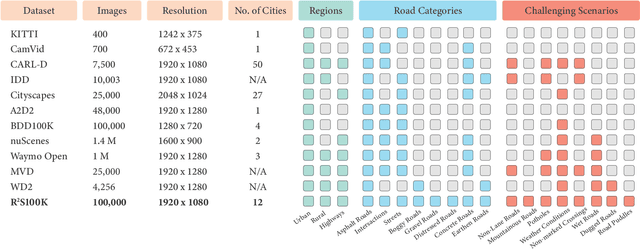
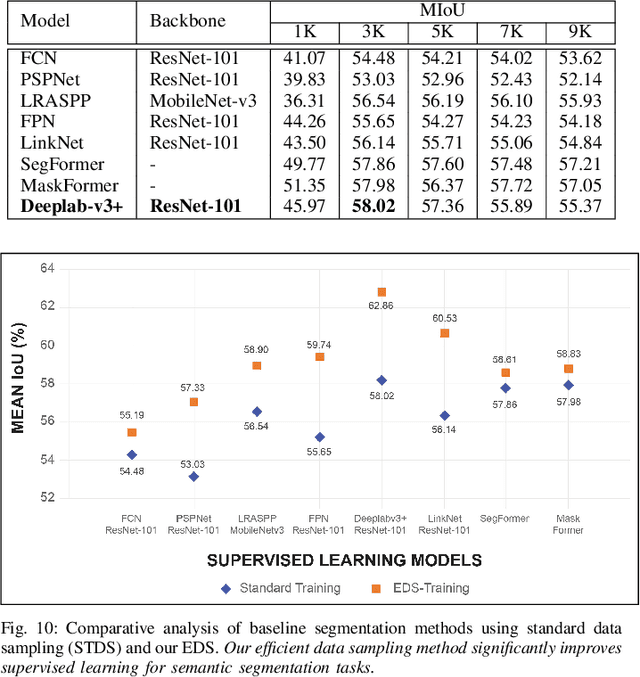
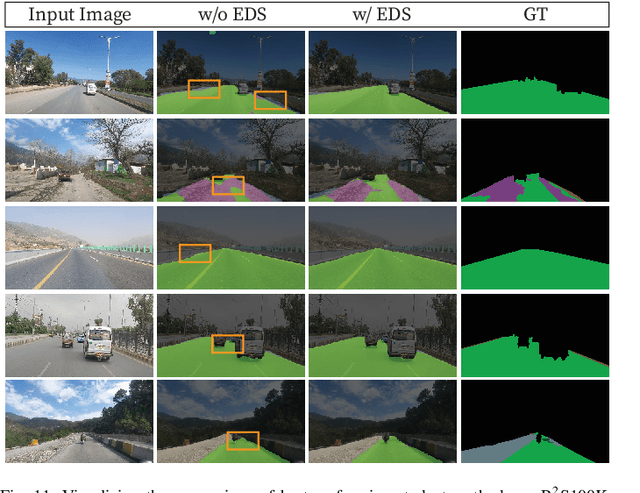
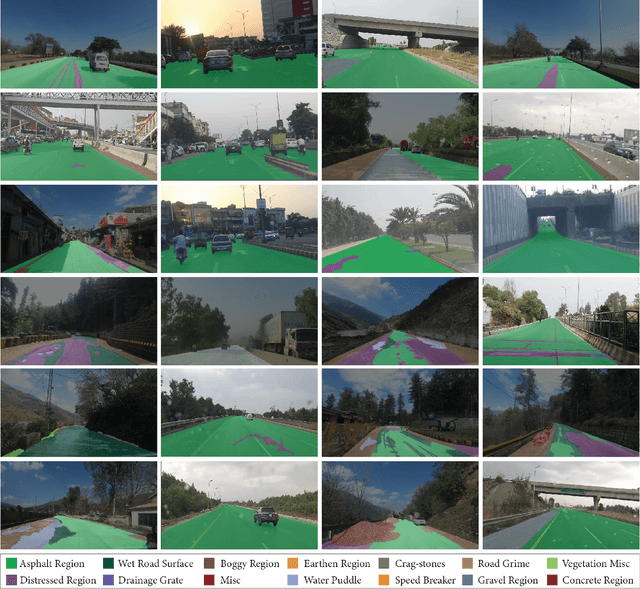
Abstract:Semantic understanding of roadways is a key enabling factor for safe autonomous driving. However, existing autonomous driving datasets provide well-structured urban roads while ignoring unstructured roadways containing distress, potholes, water puddles, and various kinds of road patches i.e., earthen, gravel etc. To this end, we introduce Road Region Segmentation dataset (R2S100K) -- a large-scale dataset and benchmark for training and evaluation of road segmentation in aforementioned challenging unstructured roadways. R2S100K comprises 100K images extracted from a large and diverse set of video sequences covering more than 1000 KM of roadways. Out of these 100K privacy respecting images, 14,000 images have fine pixel-labeling of road regions, with 86,000 unlabeled images that can be leveraged through semi-supervised learning methods. Alongside, we present an Efficient Data Sampling (EDS) based self-training framework to improve learning by leveraging unlabeled data. Our experimental results demonstrate that the proposed method significantly improves learning methods in generalizability and reduces the labeling cost for semantic segmentation tasks. Our benchmark will be publicly available to facilitate future research at https://r2s100k.github.io/.
Consistent Valid Physically-Realizable Adversarial Attack against Crowd-flow Prediction Models
Mar 05, 2023Abstract:Recent works have shown that deep learning (DL) models can effectively learn city-wide crowd-flow patterns, which can be used for more effective urban planning and smart city management. However, DL models have been known to perform poorly on inconspicuous adversarial perturbations. Although many works have studied these adversarial perturbations in general, the adversarial vulnerabilities of deep crowd-flow prediction models in particular have remained largely unexplored. In this paper, we perform a rigorous analysis of the adversarial vulnerabilities of DL-based crowd-flow prediction models under multiple threat settings, making three-fold contributions. (1) We propose CaV-detect by formally identifying two novel properties - Consistency and Validity - of the crowd-flow prediction inputs that enable the detection of standard adversarial inputs with 0% false acceptance rate (FAR). (2) We leverage universal adversarial perturbations and an adaptive adversarial loss to present adaptive adversarial attacks to evade CaV-detect defense. (3) We propose CVPR, a Consistent, Valid and Physically-Realizable adversarial attack, that explicitly inducts the consistency and validity priors in the perturbation generation mechanism. We find out that although the crowd-flow models are vulnerable to adversarial perturbations, it is extremely challenging to simulate these perturbations in physical settings, notably when CaV-detect is in place. We also show that CVPR attack considerably outperforms the adaptively modified standard attacks in FAR and adversarial loss metrics. We conclude with useful insights emerging from our work and highlight promising future research directions.
Secure and Trustworthy Artificial Intelligence-Extended Reality (AI-XR) for Metaverses
Oct 24, 2022



Abstract:Metaverse is expected to emerge as a new paradigm for the next-generation Internet, providing fully immersive and personalised experiences to socialize, work, and play in self-sustaining and hyper-spatio-temporal virtual world(s). The advancements in different technologies like augmented reality, virtual reality, extended reality (XR), artificial intelligence (AI), and 5G/6G communication will be the key enablers behind the realization of AI-XR metaverse applications. While AI itself has many potential applications in the aforementioned technologies (e.g., avatar generation, network optimization, etc.), ensuring the security of AI in critical applications like AI-XR metaverse applications is profoundly crucial to avoid undesirable actions that could undermine users' privacy and safety, consequently putting their lives in danger. To this end, we attempt to analyze the security, privacy, and trustworthiness aspects associated with the use of various AI techniques in AI-XR metaverse applications. Specifically, we discuss numerous such challenges and present a taxonomy of potential solutions that could be leveraged to develop secure, private, robust, and trustworthy AI-XR applications. To highlight the real implications of AI-associated adversarial threats, we designed a metaverse-specific case study and analyzed it through the adversarial lens. Finally, we elaborate upon various open issues that require further research interest from the community.
 Add to Chrome
Add to Chrome Add to Firefox
Add to Firefox Add to Edge
Add to Edge